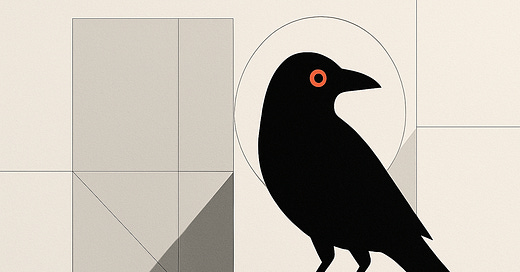Hello!
Ever watched a bird build a perfectly symmetrical nest and wondered how they do it? Well, it turns out certain wily birds might understand geometry better than we ever knew.
As I write in my latest Hindustan Times column, crows see shapes like we do. A crow doesn't need a compass or a protractor to know when something looks off.
That's the latest revelation from a study in Science Advances, which shows that carrion crows can spot geometric regularity—symmetry, parallel lines, and right angles. Two birds, no math class, and yet they could tell when a shape wasn't spot on.
We humans have long considered geometric intuition our exclusive domain. The ability to recognize orderly principles in shapes has been described as uniquely human—a basic sense underpinning centuries of thought, from Euclid's Elements to modern design.
But that story needs a footnote.
Researchers at the University of Tübingen trained two crows to play a visual game on a touchscreen. Six shapes would appear, and the task was to peck the one that didn't belong. The real test came with sets of four-sided shapes that looked almost identical—squares, parallelograms, and versions with just one angle slightly off.
Despite never encountering this challenge before, the crows performed remarkably well. They showed a pattern of performance that mirrors how humans perceive shapes.
What makes this finding striking is that other species have failed at similar tasks. Baboons, despite being far more closely related to us, couldn't learn to detect these geometric differences even after extensive training. Yet crows, whose lineage diverged from ours more than 300 million years ago, succeeded spontaneously.
Crows have been surprising people for years. They belong to the remarkably intelligent corvid family, known for solving problems that stump other animals. Crows craft tools, solve multistep puzzles, remember human faces for years, and even grasp the concept of zero. In one well-known experiment, a New Caledonian crow bent a straight wire into a hook to retrieve food—a task that requires abstract reasoning and defeats many young children.
Birds navigate complex environments, build nests with structural precision, and use spatial memory to cache thousands of food items. A natural grasp of shape and angle would be useful. What we consider abstract mathematics might, for them, be a survival skill.
The researchers don't claim that crows are unique—only that they're the first non-human animals shown to have this ability. Their findings open the door to testing other intelligent species like parrots, dolphins, and elephants.
If birds and humans both show this ability, despite their vast evolutionary distance, then perhaps geometric intuition isn't a human invention.
Move over, Euclid!





Interesting observation and research on crows! Thanks for sharing Anirban.